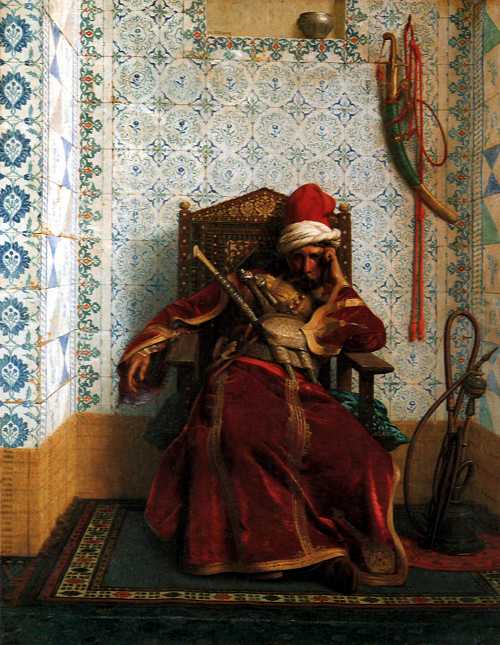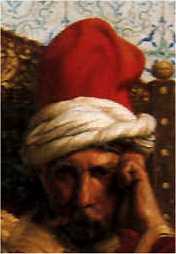
Title: "Markos Botsaris", dated 1874. By Gerome, of course.
What do you think of this one?
Examine it carefully! A look to an encyclopaedia should be useful too.
Regards,
Filiberto
Gerome's Images of "Prayer Rugs"
Hi all
As some of you are aware, the term "prayer rug" has several
meanings. This, not surprisingly, causes confusion.
One definition of the
term is any rug with an arch form at one end. Another is any rug that has been
used as the requisite clean place to pray in Moslem prayer.
The
paintings by Gerome shown in the Salon clearly illustrate both categories. One
rug that lacks a mihrab is being used for prayer in Prayer on the
Housetops, as are a few others in Prayer in the House of an Arnaut
Chief. A prayer rug with an arched form is clearly seen in Public Prayer
in the Mosque of Amr.
Filiberto asks for opinions about whether the
rugs in the paintings he shows were faithful reproductions of what the painters
saw or if significant artistic license was used in them. I think the likelihood
is very high that all of the rugs shown in the paintings presented in the Salon
are accurate records of the scenes the painters
witnessed.
Regards,
Steve Price
Hi Steve,
There’s the rub…
Some paintings are probably, as you
say, "accurate records of the scenes the painters witnessed". Others are not.
Others have only some percentage of truth.
At least one of the pictures
I showed is surely a phony.
Which
one?
Regards,
Filiberto
By the way, I forgot to add this picture to Gerome’s page:
Title: "Markos
Botsaris", dated 1874. By Gerome, of course.
What do you think of this
one?
Examine it carefully! A look to an encyclopaedia should be useful too.
Regards,
Filiberto
Filiberto -
You ask about the rug immediately above. I am responding
without consulting an encylopedia (the only one I own is a 1948 Britannica and
it's buried in my storage room downstairs) and I'm not sure that I will be very
good at the tasks posed in this salon.
My sense is that the rug pictured
immediately could have been inspired by a Talish design. These often have open
fields and rosette borders similar the one portrayed. I am not sure why the
painter seems to have picked what looks to me like gray for the field. Blue, or
red, or green would be the choices if he wanted to portray a Talish piece
accurately.
Regards,
R. John Howe
Hi John,
The rug is in the shade and the field is rather dark, but it
looks - correctly - blue on my monitor.
Did you notice anything
else?
Regards,
Filiberto
The rug has an extra border at the top (bottom) with a reddish-brown fringe: not like any Talish that I know.
Dear all,
Perhaps the Markos Botsaris portrait is the “fake” that
Filiberto mentioned. The artist Jean-Leon Gerome was born in 1824, the year
after Markos Botsaris, a Greek patriot, died, so we are left to ponder just how
much of the setting Gerome saw personally and painted in situ.
A better
title might have been Markos Botsaris as Pasha.
Some paintings have
preserved strikingly accurate details of some rugs, but we must hesitate in
supposing that art, which is an artist’s vision or interpretation, is reality.
Even the famous photographs of Native Americans by Edward Curtis are criticized
by some as misleading. Why should we expect paintings to be necessarily
accurate?
The rug may be Talish inspired, but the details are as lacking
as the symmetry of the two arms on the chair. The right arm has considerably
more slant than the left arm.
Frankly, I first thought that the hat on
Botsaris was taken from Santa Claus. Do we have any reason to believe that it is
some sort of joke?
Wendel
Bravo Wendel!


That’s one of the two answers I was
waiting for.
The man portrayed in the painting cannot be Botsaris: he was
dead the year before Gérôme’s birth.
It shouldn’t come as a surprise,
though. Gérôme produced many historical paintings portraying characters such as
Cleopatra, Cesar, Louis XIV and Moliere (not necessarily together in the same
picture).
This is much probably a studio portrait but I’m not 100% sure as
for the Harem Pool (which is the one I’m convinced is a fake).
Wendel, I
agree that the rug is Talish inspired, but you still failed to give the main
reason that makes this rug an impossible Talish. Or an improbable rug, for that
matter.
The same for you, Marvin: the extra border and the reddish-brown
fringe are strange, but not strange enough.
Look carefully…
The first
one who gives me the right answer will win a free ten years Turkotek
membership.
Better, let’s make it for eleven years!
Wendel, I disagree
about the hat: it cannot be Santa’s hat because it lacks the white tassel. 
The subject of
photography itself deserves a thread. I’ll present it
soon.
Regards,
Filiberto
Hi,
Desperately hoping you're all kidding, I'll
note:
It's a turban with a fez on
top.
Regards,
Chuck
(Neat topic Filiberto. more pictures
please...)
__________________
Chuck
Wagner
Hi Chuck,
I will post more pictures, don’t worry, but I prefer to wait
a while for more feedback on the ones already posted.
For the moment, look at
this detail:
It looks more like a turban on a Phrygian
cap.
Regards,
Filiberto
With a fez underneath. 
Still no clues?
Let’s try with a little visual help.
Here’s again
the Botsaris painting followed by a classical Talish rug.
I tried to add a
perspective to the second picture.
Please, compare the two rugs.

Regards,
Filiberto
Dear all,
those are gorgeous pictures!
I am not sure whether
that chap with his remarkable assortment of scimitars in his belt is sleeping or
in a state say of free floating attention. He is overdoing it quite a bit with
his three things, overcompensation is the modern phrase I imagine, I suspect him
being a eunuch for that reason. Anyway, he most likely would have made sure that
Mr Gérôme had wetted his brush for the last time in his life if the picture in
the hamam was not a fake.
Very inspiring portrait of that other beauty.
Now I know what we´ll be having for supper tomorrow: Circassian Chicken.
Best wishes,
Horst Nitz
no medachyl
Filiberto,
The Talish rug in the painting has no medachyl,recriprocal
inner border lining the field. Either this or a zig-zag is virtually universal
on Talish rugs of this type.
There are also quite a few rosettes in the upper
border. Normally there would be four or, at most, five. The field itself is
quite a bit wider than typical Talish rugs, too.
In conclusion, one must
suspect that this is the only known example of the extremely rare
Gerome-Variant-Talish.
(or, it underwent extreme re-vitalization at the hands
of an unscrupulous re-weaver in Turkey)
Patrick Weiler
Hi Pat,
Congratulations!!!
You won an eleven-years Turkotek
membership.
quote:
There are also quite a few rosettes in the upper border. Normally there would be four or, at most, five. The field itself is quite a bit wider than typical Talish rugs, too.

Hi People
There is also the possibility that it wasn't a Talish to
begin with. The field isn't visible, and may have had some decoration on it. The
border design is common on Talish rugs, but isn't exclusive to
them.
Regards,
Steve Price
Dear folks -
It may well not be even Talish inspired but the presence
of designs in the field wouldn't disqualify it. There are Talish pieces that
have field designs. I may own a fragment of one. Wright and Wertime show an
"anchor piece" photographed in 1889 and designated "Talish," that has botehs in
the field.
Some claim that true Talish pieces have extra reinforcing
wefts, often in blue, visible on their backs. Of course, Wright and Wertime
ultimately seem to give up the designation entirely, saying that the rugs called
"Talish" "are best described as of indeterminate
origin..".
Regards,
R. John Howe
Incarcerated?
Filiberto,
Does the 11 year sentence run concurrently with my ongoing
several years of Turkotraz sentence, or is it consecutive?

Your Pen Pal,
Patrick
Weiler
Hi Steve,
No matter how do we call it, it’s a rug 11 units wide and 10
units long…
One has to ask where is Gérôme photographic skill here - the
skill he shows in the "Circassian Lady" painting, where the rendering of the
Akstafa prayer rug seems quite faithful.
Perhaps the Talish was painted from
a not very detailed sketch or, if the rug was used in his studio, he didn’t have
the patience to draw the medachyl border and he took a license widening the
rug…
Do the carpets in the others Gérôme’s paintings shown here look
plausible? I didn’t notice anything wrong in them. What do you
think?
Patrick, about your membership, I think it is consecutive… you are
entitled to appeal, though. 
Regards,
Filiberto
Hi Filiberto
I find nothing implausible about the rug, but if we
consider Gerome to be a painter who paid attention to accuracy (which appears to
be the case, for the most part), then the rug probably isn't a Talish, but
perhaps a Karabagh with the border design typical of Talish rugs.
Regards
Steve Price
Hi Steve,
As you like…
Still, IF the distance between elements is
constant all over the border, this is a Karabagh more wide than long. And that
is the implausibility.
Regards,
Filiberto